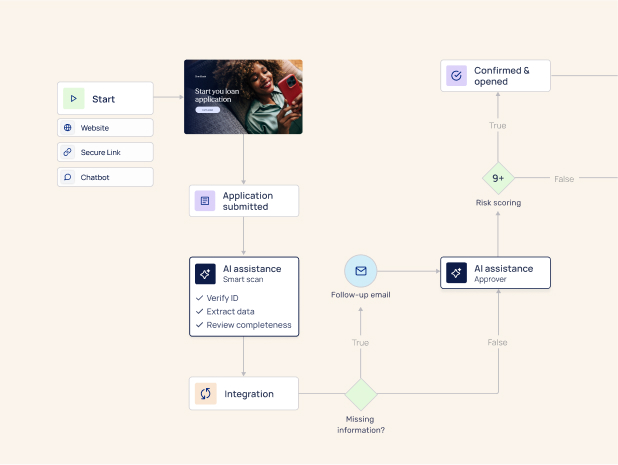Manual processes are the worst enemy of great customer experiences. In this digital age where everything revolves around digital channels, digital customer journeys are key. Financial institutions should ease customer access to their services online.
Despite all the talk about digital transformation, banks still manage many customer-facing processes via manual workflows and clunky paperwork: account openings, loans, savings, digital customer identification (know your customer/KYC), producing friction and frustration for the customer.
Digital transformation of the customer journey is not only an opportunity but also a necessity for financial institutions: it's the only way they can better serve their digital customers. Banks need to act now to digitize their customer-facing processes if they want to keep up with changing digital behavior and expectations.
What is digital customer journey transformation?
Digital customer journey transformation is the process of transforming existing manual processes into digital ones which enable customers to complete tasks efficiently, quickly, and seamlessly.
The digital customer journey achieves two main objectives: to provide an improved digital customer experience; and to increase the productivity of your team. When done right, digital journey transformation provides better service, increases productivity, and reduces costs.
In financial services, digital customer journey digitalization can greatly impact profitability. A recent study by the Boston Consulting Group found that banks with strong digital sales processes and seamless onboarding can boost conversion rates by 10-15% in the first year.
[.figure] 10-15% [.figure]
[.emph]boost to conversion rates for banks with strong digital sales processes and seamless onboarding [.emph]
Financial institutions need to find digital tools that are useful for their digital customers, easy to use and aesthetically pleasing. Customer journeys should be designed in a way that enables digital customers to complete digital tasks more quickly than they would using traditional manual processes.
In order to assess a digital customer journey digitization project's ROI, its benefits and costs need to be measured against each other.
Benefits of digital journey transformation
According to digital experts, digital customer journey transformation for financial institutions should impact the four biggest digital performance pillars:
- efficiency and effectiveness
- digital and physical experience
- digital service delivery
- and digital culture
Boost conversion rates
A digital customer journey digitalization project will provide a digital customer experience that can increase profitability through increased conversions and increased productivity.
Another way digital customer journey digitalization can impact conversions is by leveraging digital tools such as voice response and interactive digital platforms like chatbots to provide real-time responses to customer queries.
Digital journeys make it easier for customers to interact with their bank, leading to an increased digital sales process' conversion rate.
In banking, digital channels can increase digital sales process' conversion rates by 15% and digital deposit account opening conversion rates by 30%.
Boost customer satisfaction and loyalty
[.emph]Digital customer journey makes it possible to provide customers with better experiences and increase both adoption and retention rates.[.emph]
It also helps sales and customer service teams become more efficient in serving digital customers responding to customer requests quicker, which leads to improved satisfaction levels and increased loyalty.
The digital journey provides sales and customer service teams with more insights into digital customer behavior and feedback, which can enable them to better understand customer needs.
Additionally, digital customer journey digitalization can provide banks with more digital data about their customers' needs, enabling them to shape products and services that better serve their customers. This, in turn, allows banks to create digital products or offer digital services that are both appreciated by customers and more impactful for the bank.
Save costs related to servicing digital customers
Digital customer journeys reduce costs through increased self-service and digital adoption, which reduces the number of interactions between customers and employees.
By eliminating bottlenecks and siloes, digital customer journeys can help digital teams become more efficient in serving customers responding to customer requests more quickly. For example, digital customer journeys which use push notifications to alert users about events like low funds or expired cards can reduce the number of phone calls made by employees and enable customers to resolve issues by themselves before they escalate to the customer service team.
Create a digital culture
Digital transformation is not about technology. Technology is the enabler of digital transformation, but the drivers are the digital culture and digital business models.
Digital culture enables your employees to view digital transformation as an opportunity, rather than a threat and empowers them to take control of the changes they are leading themselves.
It also means that your employees are empowered to embrace new digital technologies and digital business models.
Boost sales team efficiency
A digital customer journey digitization project allows banks to improve digital sales productivity by identifying inefficiencies within sales processes and leveraging new technologies that help employees successfully resolve these problems in order to:
- improve the digital sales process transparency and speed;
- increase digital sales productivity and digital sales effectiveness;
- and reduce digital sales costs through shorter onboarding times, reduced inquiries, and lower self-service costs.
Customer journey digitization projects can help sales managers identify digital sales process bottlenecks. For example, digital account opening workflow increases sales process' efficiency by reducing the preparation time before an account opening appointment as well as the digital account opening appointment duration.
By using data analytics and machine learning tools, digital channels (for example, web and mobile applications) allow digital sales process managers to identify digital sales customers who are most likely to benefit from digital financial products and deliver digital product recommendations. For example, digital delivery of digital financial product recommendations to potential customers has helped some banks improve conversions by 80%.
[.figure] 80%[.figure]
[.emph] boost to conversion rates[.emph]
Improve customer service efficiency
Digital customer journey also has a positive impact on customer service as digital channels can reduce call volumes and reduce cost per interaction for customers.
Digital customer journey digitalization allows banks to reduce call volumes by alerting customers about product or service changes before they happen, enabling them to take action in digital channels.
For example, SMS alerts about digital account closure can help financial institutions reduce digital account closure calls by 25%. Enabling digital self-service options for digital financial accounts can include digital password resets and digital statement reminders.
[.figure]25%[.figure]
[.emph]Reduced digital account closure calls[.emph]
Digital customer journeys can also help banks identify process bottlenecks within customer support teams and allow them to improve the efficiency of customer support by automating customer support workflows and reducing the time spent by employees to resolve complaints.
Consolidate digital applications to enable better integration with third parties
Digitalization also allows financial institutions to better integrate with third parties in order to provide clients with a full digital experience that includes all of the digital tools they need to complete digital tasks, including eSignatures, e-KYC,and other processes.

The costs of digital transformation
Not all digital customer journey digitization initiatives will provide an ROI for financial institutions. There are several factors that could impact the overall value of a digital customer journey digitization project.
One crucial factor is the cost of digital transformation.
Digital customer journey digitization projects can be expensive and time-consuming. Implementing digital channels such as a self-service website or digital tools that enable customers to complete digital tasks will require a significant investment by companies that provides no guarantee of an ROI.
Additionally, the transformation from manual processes into digital customer journeys digitalization will require a digital transformation roadmap that should be carefully planned and analyzed.
Digital customer journey digitization projects need to have a clear goal defined before they start because, if digital customer journey digitalization is not properly executed, it can actually cause more harm than good.
For example, a digital customer journey digitization project that fails to meet digital customer needs will result in digital customer service that is frustrating and dissatisfying.
However, digital customer journey digitalization is a digital transformation initiative that generates significant value for financial institutions if it's done right.
Reducing the risk of digital journey transformation with no-code tools
Digital journey digitization projects are often long-term initiatives that require significant investment. Therefore, it's important for companies to closely monitor digital customer expectations throughout the digital journey digitalization process so they can meet or exceed them.
It's also important for financial institutions to allocate sufficient resources during the digital transformation journey digitization process, otherwise, it might fail due to insufficient budget, lack of knowledge, or other factors.
[.emph]One way to reduce the cost is to utilize no-code/low-code development tools to digitize digital customer journeys. This is because no-code platforms empower business users to quickly prototype, design, launch, and test digital customer journeys with minimal development resources.[.emph]
No-code platforms can help banks reduce costs by streamlining the transformation of manual processes into digital journeys in a way that is more efficient and less expensive than traditional IT-driven projects.
In the end, it's all about reducing costs while increasing productivity and customer experience to increase profits. In a world where digital transformation is accelerating at an unprecedented pace, digital customer journeys are key in the quest of increasing customer satisfaction.





